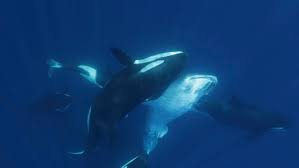Share This Article
The dinner menu for the world’s orca whales is pretty varied. Some, like the crafty transient killer whales in the Pacific northwest, use canyons to hunt other marine mammals, while others feast on salmon exclusively. One pod in the Gulf of California, may have picked up a new skill to go after a pretty big prize–whale sharks. Reaching almost 60 feet long, whale sharks are the largest fish on the planet and can certainly feed a big and hungry orca whale. The findings are detailed in a study published November 29 in the journal Frontiers in Marine Science.
Whale sharks tend to feed at aggregation sites in the southern Gulf of California off the coast of Mexico. Some of the fish that gather are still rather young and small, making them a bit more vulnerable to attack by larger animals. For years, anecdotal evidence suggested that orcas could be hunting the whale sharks. Now, a team of scientists in Mexico have reported four separate hunting events.
“We show how orcas displayed a collaboratively hunting technique on whale sharks, characterized by focusing on attacking the pelvic area causing the whale shark to bleed out and allow orcas access to the lipid-rich liver,” Erick Higuera Rivas, a study co-author and marine biologist at Conexiones Terramar, said in a statement. “One individual was engaged in three of the four events, alongside with other members who might belong to a pod specialized on hunting on sharks.”
The predation events detailed in the new study happened between 2018 and 2024 in the southern Gulf of California. The images and videos were taken by members of the public and scientists. The individual orcas were identified by analyzing photographs of their dorsal fins and distinctive features like scars and white patches.
A male orca that locals call Moctezuma was there for three of the four hunting events. A female orca that has previously been observed in the presence of Moctezuma participated in one event, suggesting they could be related or are members of the same pod.
“When hunting, all pod members work together, hitting the whale shark to turn it upside down. In that position the sharks enter a state of tonic immobility and can no longer move voluntarily or escape by going deeper,” Higuera Rivas said. “By keeping it under control, the orcas then have greater ease and speed in approaching the pelvic area of the shark and are able to extract organs of nutritional importance for them.”
The team believes that the orcas may be targeting whale sharks’ ventral side–the area near their bellies. This part of their bodies is the least protected, so is particularly vulnerable. There is less muscle and cartilage on their ventral side, which would allow the orcas easier access to important blood vessels like the aorta. While whale sharks’ livers are an important part of orcas’ diets, the team did not capture any images of the orcas consuming this vitamin-rich organ.
The method of hunting may imply that some orcas in the Gulf of California have acquired a special set of skills–like going after the ventral side of young whale sharks–that help them prey on these enormous fish. Orcas may have learned to do the same thing in other parts of the world, but evidence is limited, according to the team.



